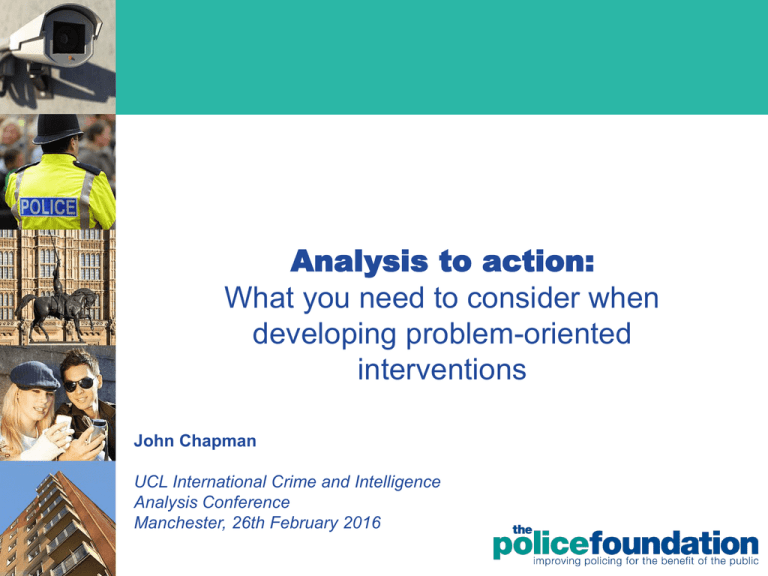Analysis to action: What you need to consider when developing problem-oriented
advertisement

Analysis to action: What you need to consider when developing problem-oriented interventions John Chapman UCL International Crime and Intelligence Analysis Conference Manchester, 26th February 2016 Session overview • Examining the crucial ‘analysis to action’ phase within the SARA model - the bit after Analysis that leads up to Response • What’s the SARA model? – more on that later… • This session will explore some of the core intervening activities and dependencies that form the basis of the ‘analysis to action’ axis • Those factors that are key to enabling successful transition from analysis to practicable, locally-tailored responses The Police Foundation • Independent charitable think-tank set-up in 1979 • Foundation aims to improve policing for the benefit of the public • Practice improvements generated through independent research, training and consultancy • Contribute to the development of policing policy nationally through promoting debate • Currently focussed on two major projects, one of which is examining Police Effectiveness in a Changing World Analysis to action – scene setting • Police are renowned for their quick response and ‘cando’ attitude • Preventing and reducing crime and community safety problems (rather than just stepping in) requires more than good reactions, however • The analyst’s role is very important in generating the necessary knowledge about problems, but only takes the process so far • Taking a project through to successful implementation requires working through a series of successive, critical activities Overview of SARA • Origins of SARA in Problem-Oriented Policing (POP) theory • SARA ordered as a four stage problem solving process: Identifying and prioritising problems Scanning Reviewing what was implemented and its effects Assessment Analysis Response Implementing activities to address the identified causes Exploring and explaining what is happening and why? SARA – a model of simplicity? • The apparent simplicity of SARA is a key reason why it is widely heralded • Proponents say this simplicity makes it user friendly • SARA was shown to be the problem-solving method favoured by 84% of practitioners in a UK survey (1) • 61% of respondents agreed that the model was simple to apply in practice • 30% of SARA advocates felt that it had no weaknesses …or deceptively complex? • The application of SARA theory in a real world context, particularly the post analysis phases, is challenging • Although SARA might imply otherwise, problem-oriented responses do not follow automatically (or simply) from analyses • Critics say that whilst SARA offers an easily grasped introduction to POP, it lacks depth of detail to guide further action (2) • It is also accused of over-simplifying what is actually a very involved process (3), which may lead practitioners to underestimate the complexities of POP …or deceptively complex? • This is important because community safety initiatives have often been criticised by their failure to replicate the mechanisms of success and “the intelligent process of going from analysis to intervention to implementation” (4) • SARA accentuates the importance of analysis in POP and that Response should be grounded in Analysis • However, it says very little about the process of moving from one step to the other • It is in this key ‘transitional’ phase where a number of intermediary activities and dependencies are pivotal Working with partners in two project sites • The Police Foundation has recently completed this process as part of our Police Effectiveness in a Changing World project • This looked to generate insights into how the police, working with local stakeholders, can effectively tackle crime at a time when both the crime problems faced and the resources available are changing • Utilising a SARA approach, the project set out to devise, implement and assess locally-tailored, evidence-based, sustainable solutions to persistent local crime problems in two towns Working with partners in two project sites • The experience provided the opportunity of testing SARA principles in the real world • It afforded valuable insight into the challenge of transforming research and analysis into deliverable crime reduction work • Significantly, we have learned that it takes time, effort and commitment to navigate the ‘analysis to action’ axis and complete the intermediary steps • Each of these steps will be explored in-turn, under two broad themes: programme design, and planning and preparation Programme design • Involves moving from the descriptive findings, theories and hypotheses produced by analysis, to a wellformulated, coherent vision of what can be done to address the problem ‘on the ground’ • Focussing on programme design is core to the problemsolving process • Without it, any response informed by analysis is merely a reflex • It involves answering the question: in light of what we know, what stands the best chance of succeeding? Programme design • However, it would be wrong to think what we know and do is entirely the product of analysis. The problem needs to be placed in a wider contextual framework, paying heed to: - Consultation - Wider available evidence - Organisational memory - Local fit - Resourcing - Feasibility Programme design • Assimilating analytical output with these wider activities and dependencies is crucial • The design process should culminate in a vision; a realistic statement of what can and should be done • At this stage, design yields to planning and preparation • Again the typical urge to progress things as quickly as possible needs to be reined-in Planning and preparation • Developing and working through a plan that sets out how to get to the point of delivery, inevitably highlights a number of additional (important) tasks: - Communicating the vision to stakeholders - Assigning roles - ‘Mapping the route’ to be followed - Identifying skills gaps/learning needs - Developing appropriate output and outcome mechanisms The elephant in the room • Getting from an evidence-based analytical understanding of the ‘problem’ to a logical and effective response is reliant on a key component - leadership • Someone to carry out the design functions • To help win hearts and minds, and plan, prepare and drive things forward on the ground • Supported by leadership in the form of advocacy from local strategic/senior stakeholders The elephant in the room • In our two sites, Foundation staff fulfilled the day-to-day project coordination role • Without our input, the project would have unlikely been progressed to the same extent • In one site, we would have experienced rapid implementation failure • The support of key local leads in the other site helped sustain ‘programme fidelity’ • It wouldn’t be easy to replicate our role, but leadership remains an important component Further information Look out for forthcoming publications from the Police Effectiveness in a Changing World Project Web: www.police-foundation.org.uk Twitter: @the_police_fdn Email: john.chapman@police-foundation.org.uk References (1) Sidebottom, A. and Tilley, N. (2010) Improving problem-oriented policing: The need for a new model? Crime Prevention and Community Safety (2010) 0, 1–23 (2) Ekblom, P. (2007) Appropriate Complexity: Capturing and Structuring Knowledge from Impact and Process Evaluations of Crime Reduction, Community Safety and Problem-Oriented Policing. In Hogard, E., Ellis, R. and Warren, J. (Eds) (2007) Community Safety: Innovation and Evaluation. Chester: Chester Academic Press. (3) Sidebottom (4) Ekblom, & Tilley, ibid. ibid. p. 81




